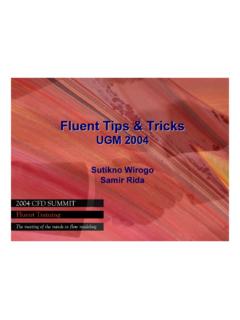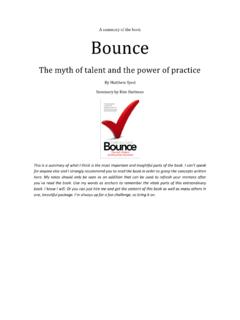Transcription of Chapter 7. Magnetic Recording Fundamentals - Ian …
1 Computer PeripheralsSchool of Computer EngineeringNanyang Technological UniversitySingaporeThese notes are part of a 3rd year undergraduate course called "Computer Peripherals", taught at Nanyang Technological University School of Computer Engineering in Singapore, and developed by Associate Professor Kwoh Chee Keong. The course covered various topics relevant to modern computers (at that time), such as displays, buses, printers, keyboards, storage devices The course is no longer running, but these notes have been provided courtesy of him although the material has been compiled from various sources and various people. I do not claim any copyright or ownership of this work; third parties downloading the material agree to not assert any copyright on the material.
2 If you use this for any commercial purpose, I hope you would remember where you found reading is suggested at the end of each Chapter , however you are recommended to consider a much more modern alternative reference text as follows:Computer Architecture: an embedded approach Ian McLoughlinMcGraw-Hill 2011 Chapter Recording FundamentalsComputer memories are divided into two types. Main or working memories includingRAM's, ROM's and other semiconductor devices which are directly addressable by the CPU,and mass storage devices. Mass storage memories generally are not directly addressable by theCPU, have a slower access method, are non-volatile and often removable off-line and have amuch lower cost per bit. Mass storage devices may be classified into Magnetic hard disks andfloppy disks, several types of Magnetic tape drives, and various kinds of optical disk drives.
3 Inadditional, there are the many varieties of card storage devices like Magnetic cards, smartcards, ROM, RAM and flash memory cards, but these will not be discussed here. Except forthe CD-ROM in which data is represented by physical indentations or pits, practically all otherwrite-able mass storage devices make use of the Magnetic or magneto-optical (M-O)characteristics of the Recording media to store the required information. Thus we shall firstconsider some basic principles used in Magnetic Recording and the performance of the digitalrecording Magnetic Material CharacteristicsWhen a piece of Magnetic material is moved past a Magnetic field, usually created by anelectromagnet, it becomes magnetised.
4 Similarly, when the magnetised material is moved pastan unenergised coil, it induces a voltage across the coil. This is just Faraday's law ofelectromagnetic induction, which relates the voltage induced to the Magnetic field strength. Anumber of parameters are used to characterise Magnetic materials:(a) Coercivity Hc is the measurement the level of difficulty to magnetise thematerial. For storage media, a high coercivity is desired in order thatinformation stored will be preserved in the presence of stray Magnetic fieldsthat may be present. High coercivity also implies that a strong Magnetic fieldis needed to record information onto it. Magnets with high coercivity arecalled hard magnets.(b) Remanence Br is the amount of magnetisation that remains after themagnetic field is removed.
5 Soft iron used for electromagnets are chosen tohave low remanence so that it will respond efficiently to the appliedelectromagnetic field.(c) Magnetic domains are small regions in the Magnetic media which may bemagnetised independently of adjacent regions, so that adjacent domains canhave opposite polarities. The size or granularity of these domains have animportant bearing on the density of information that can be stored.(d) Flux reversal occurs when a change in polarity is encountered while movingfrom one domain to the next. The storage density of the media is measuredby the flux reversal per inch (frpi) or the flux change per inch (fcpi). Recording Fundamentals2 Figure 0-1 shows the B-H characterisation curves for soft and hard Magnetic MAGNETHARD MAGNETH > 100 OeH<10 OeccBBHHHcHcBrBrFigure 0-1.
6 B-H magnetisation Read/Write headThe "guts" of a Magnetic Recording system are: the write head, the Magnetic medium,and the read head. (The write head could be the same as the read head and usually has beenthe case for disk drives.) The write head is driven by a current source that carries theinformation to be stored. The write head radiates flux, which changes the state of magneti-zation of the Magnetic medium immediately under the head. Actually, since the head ismoving with respect to the Magnetic medium, any point on the Magnetic medium retains thestate of magnetization corresponding to the last flux it experienced from the write head as thehead moves away from that a rigid disk, the disk moves in a circular motion under the head.
7 Information isstored on the disk in concentric tracks, the width of a track roughly being governed by the sizeof the write head. The density of Recording per sq inch (known as areal density) is the productof the number of tracks per inch (tpi) and the linear density of information along a trackmeasured in bits per inch (bpi). Typical numbers for today's high end ( , expensive) rigiddisk drives are: 3,000 tpi and 30,000 current into the write head induces a magnetization pattern on the track immediatelybelow the write head. When a track is to be read, a read head is positioned over the , the magnetization pattern "frozen" on that track radiates flux that is sensed, or "read,"by the read head.
8 The read head produces a voltage that is symptomatic of the magnetizationon the track being read. There are primarily two types of read head: inductive heads whichcontain coils of very fine wire and which produce a voltage proportional to the time derivativeof the flux that passes through its coils, and magneto-resistive (MR) heads which produce avoltage directly proportional to the flux sensed by the head. MR heads produce larger readvoltages than inductive heads, but have a limited dynamic range for linear operation. Onlyinductive heads have been used for writing, to this Recording Fundamentals3 Consider the familiar audio cassette tape recorder in Figure 0-2. The Recording /playbackhead is made of easily magnetised ferrite material and has a small air-gap at the point whereit comes into contact with the Recording tape, = 0.
9 When energised, the coil winding on thestructure is used to create a strong and concentrated Magnetic field on the Recording media asit moves along with a velocity v. During the playback mode, this coil detects the inducedvoltages. iwnsnsnsv Recording mediamagnetic dipolesmagnetic fluxgaphead distancemedia velocityfringing fieldsubstrateFigure 0-2 Basic Ring read/write Recording media in this case is a length of MYLAR (plastic) tape coated with apowdered ferric oxide compound which is magnetisable and has high remanence. This layer ofmagnetic material in the unmagnetised state may be conceived as made up of dipoles, tinymagnets with N-S poles randomly positioned. Under the influence of the external magneticfield, these dipoles will align their N-S poles in line with the applied field thus becomingmagnetised.
10 Upon removal of the applied field some of these dipoles remain either increasing the rate v the media is moved across the head, or by decreasing thegranularity of the Magnetic material, ( making the tiny magnets smaller), we can recordfaster changes in the applied Magnetic field, that is, the frequency response is increased. Fordigital data, the density of the stored information increase with decrease in the granularity ofthe Magnetic a weak field, only a small number of the dipoles retain their alignment. As thefield gets stronger, more and more of them will remain aligned, that is, the stored magneticfield increases. For audio (analogue) Recording , the variation in the audio signal levels arerecorded in this linear region of the Magnetic behaviour.







